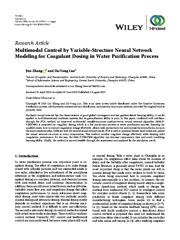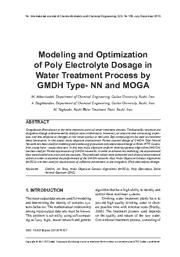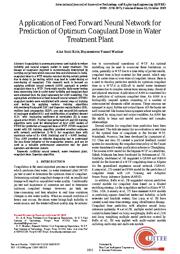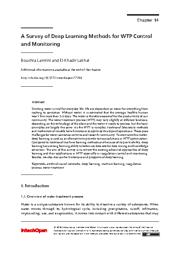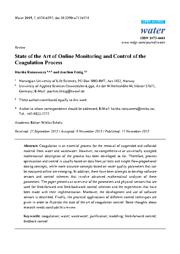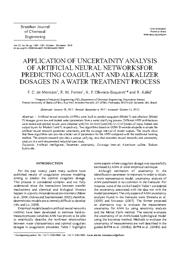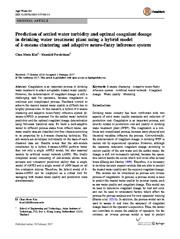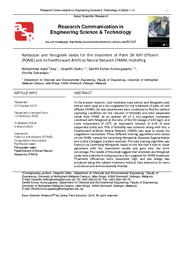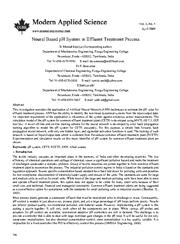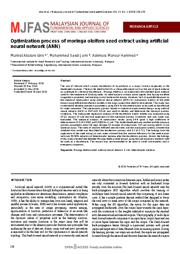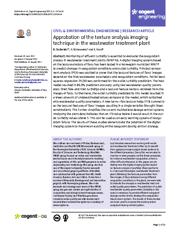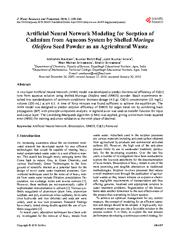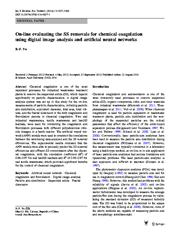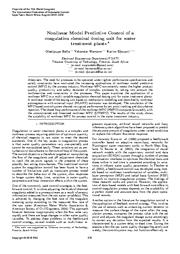A copy of this work was available on the public web and has been preserved in the Wayback Machine. The capture dates from 2020; you can also visit the original URL.
The file type is application/pdf.
Filters
Multimodal Control by Variable-Structure Neural Network Modeling for Coagulant Dosing in Water Purification Process
2020
Complexity
Stochastic neural network has the characteristics of good global convergence and fast gradient-based learning ability. ...
In this paper, combined with rule base, through the PCA method, an improved multimodal variable-structure random-vector neural network algorithm (MM-P-VSRVNN) is proposed for coagulant dosing, which is ...
Acknowledgments is study was funded by the Natural Science Foundation of Hunan Province (Grant no. 2018JJ3891). ...
doi:10.1155/2020/5392417
fatcat:vzb3gqmi5bfzdbgf7yndqsp42m
Modeling and Optimization of Poly Electrolyte Dosage in Water Treatment Process by GMDH Type- NN and MOGA
2013
International Journal of Chemoinformatics and Chemical Engineering
In this paper, multi-objective evolutionary Pareto optimal design of GMDH Type-Neural Network has been used for modeling and predicting of optimum poly electrolyte dosage in Rasht WTP, Guilan, Iran, using ...
The predicted values were compared with those of experimental values in order to estimate the performance of the GMDH network. ...
So far, the polynomial equation, neural network models, and fuzzy structures have been used for predicting and modeling of coagulant dosage. ...
doi:10.4018/ijcce.2013070107
fatcat:rwuuewjhejfvvfsh6rmymcdlxi
Application of Feed Forward Neural Network for Prediction of Optimum Coagulant Dose in Water Treatment Plant
2019
VOLUME-8 ISSUE-10, AUGUST 2019, REGULAR ISSUE
This research work is focused on applying artificial neural network (ANN) approach to predict coagulant dose in a WTP. ...
The appropriate architecture of feed forward neural network (FFNN) coagulant models were established with several steps of training and testing by applying various training algorithms vizLevenberg-Marquardt ...
This research work is focused on applying artificial neural network (ANN) approach to predict coagulant dose in a WTP. ...
doi:10.35940/ijitee.l2864.1081219
fatcat:dn7k4726d5gbdkk4awvohdp4sa
A Survey of Deep Learning Methods for WTP Control and Monitoring
[chapter]
2018
Desalination and Water Treatment
The aim of this survey is to review the existing advanced approaches of deep learning and their applications in WTP especially in coagulation control and monitoring. ...
The water treatment process (WTP) may vary slightly at different locations, depending on the technology of the plant and the water it needs to process, but the basic principles are largely the same. ...
The use of deep neural networks for process modeling and control in the drinking water treatment is currently on the rise and is considered to be a key area of research. ...
doi:10.5772/intechopen.77196
fatcat:iky66dss4nga7j22xfcwbwuk4y
State of the Art of Online Monitoring and Control of the Coagulation Process
2015
Water
Therefore, process optimization and control is usually based on data from jar tests and simple flow-proportional dosing concepts, while more accurate concepts based on water quality parameters that can ...
Finally, the practical applications of different control techniques are given in order to illustrate the state of the art of coagulation control. ...
Acknowledgments The paper was prepared during a sabbatical term of one of the authors. The funding from both universities is gratefully acknowledged. ...
doi:10.3390/w7116574
fatcat:yu3xmhwtc5d3vapqcwmv2xvrcy
APPLICATION OF UNCERTAINTY ANALYSIS OF ARTIFICIAL NEURAL NETWORKSFOR PREDICTING COAGULANT AND ALKALIZER DOSAGES IN A WATER TREATMENT PROCESS
2018
Brazilian Journal of Chemical Engineering
Artificial neural networks (ANNs) were built to predict coagulant (Model I) and alkalizer (Model II) dosages given raw and treated water parameters from a water clarifying process. ...
Two algorithms based on GUM-S1weredevelopedto evaluate the artificial neural network parameter uncertainty and the coverage interval of model outputs. ...
ACKNOWLEDGEMENTS The authors thank FAPESB (process BOL1597/2008) for financial support, Clean Technology Network of Bahia (TECLIM) for general support and Mario Cezar Matosfor the fruitful discussions. ...
doi:10.1590/0104-6632.20180354s20170039
fatcat:tm5yso2znzck7jk4f7yehvfu6u
Prediction of settled water turbidity and optimal coagulant dosage in drinking water treatment plant using a hybrid model of k-means clustering and adaptive neuro-fuzzy inference system
2017
Applied Water Science
In this research, a hybrid of k-means clustering and adaptive neuro-fuzzy inference system (kmeans-ANFIS) is proposed for the settled water turbidity prediction and the optimal coagulant dosage determination ...
The finally completed model consisting of sub-models shows more accurate and consistent prediction ability than a single model of ANFIS and a single model of ANN based on all five evaluation indices. ...
Acknowledgements The authors would like to thank the staffs who are working at Basnong water treatment plant in Changwon city, South Korea for supporting the data in this research. ...
doi:10.1007/s13201-017-0541-5
fatcat:gzxptyjdora4pms4vitdowrd2m
Neural network-based pH and coagulation adjustment system in water treatment
2023
IAES International Journal of Artificial Intelligence (IJ-AI)
The construction of the automatic learning model had a comprehensive implementation and improvement field through continuous system training, which allowed an optimal dosage of Aluminum Sulfate and Lime ...
The supervised learning model has been addressed starting from the knowledge of data color, turbidity and pH at the water inlet to the aqueduct and the dosing results of type A aluminum sulfate and calcium ...
ACKNOWLEDGEMENTS The authors are grateful to Universidad de los Llanos who supported and funded through Directorate General Research under research project "Design and construction of an automated equipment ...
doi:10.11591/ijai.v12.i2.pp560-567
fatcat:bvklhrlwljdf3bny24xevli62e
Rambutan (Nephelium lappaceum) seeds for the treatment of Palm Oil Mill Effluent (POME) and its Feedforward Artificial Neural Network (FANN) modeling
2020
Research Communication in Engineering Science & Technology
Along with this, a Feedforward Artificial Neural Network (FANN) was used to model the coagulation mechanism. ...
At an optimal pH of 3, bio-coagulant dosage of 600 mg/L and room temperature of 28⁰C, an impressive removal of 65% of total suspended solids and 79% of turbidity was achieved. ...
Wu & Lo (2008) also reported training the ANN and Adaptive Network Based Fuzzy Interference System (ANFIS) to predict the dosage of PAC required for water treatment. ...
doi:10.22597/rcest.v4.64
fatcat:lntvpnrjmvhh5mvzt6ep3mmclu
Neural Based pH System in Effluent Treatment Process
2009
Modern Applied Science
The training of such network is based on Input-Output data which is collected from Perundurai common effluent treatment plant (PCETP). ...
For this purpose, a simple feed forward, back propagation neural network, with only one hidden layer, and sigmoidal activation functions is used. ...
In 1998, Lin-En Kuo et al said that the Neural Network based Model Predictive Controller (NNMPC) is applied to the control of coagulant dosing in a drinking water treatment plant. ...
doi:10.5539/mas.v3n4p166
fatcat:gee2lf7f7vaktbnmc74unmmjz4
Optimization process of moringa oleifera seed extract using artificial neural network (ANN)
2019
Malaysian Journal of Fundamental and Applied Sciences
The optimization process based on statistical experimental design using artificial neural network (ANN) in MATLAB 2012A was used to identify and determine the optimum process conditions. ...
However, lack of available literature on the statistical optimization using artificial neural network (ANN) for inactivation kinetics of the seed extract using different disinfection models is the major ...
ACKNOWLEDGEMENT The authors were grateful to the Ministry of Higher Education (MOHE) Malaysia, for financing the research project under the research initiative grant (RIGS16-075-0239) and to Department ...
doi:10.11113/mjfas.v15n2.1104
fatcat:qe3yneefsvaxnmocykzfeb75rq
Approbation of the texture analysis imaging technique in the wastewater treatment plant
2017
Cogent Engineering
A digital imaging system based on the texture analysis of flocs has been tested in a Norwegian municipal WWTP to predict changes in coagulation conditions and outlet turbidity. ...
The results of these studies demonstrate the potential of the digital imaging system to improve an existing online coagulant dosing control strategy. ...
The improvement of existing on-line dosage control system is a key focus of this research. ...
doi:10.1080/23311916.2017.1373416
fatcat:6utzjmpmwbhzfiawyplcel5doa
Artificial Neural Network Modeling for Sorption of Cadmium from Aqueous System by Shelled Moringa Oleifera Seed Powder as an Agricultural Waste
2010
Journal of Water Resource and Protection
A two-layer Artificial Neural Network (ANN) model was developed to predict the removal efficiency of Cd(II) ions from aqueous solution using shelled Moringa Oleifera seed (SMOS) powder. ...
Batch experiments resulted into standardization of optimum conditions: biomass dosage (4.0 g), Cd(II) concentration (25 mg/L) volume (200 mL) at pH 6.5. ...
Khemani, Head, Department of ...
doi:10.4236/jwarp.2010.24039
fatcat:qv2spzvexzdfhonqpl74dz3txy
On-line evaluating the SS removals for chemical coagulation using digital image analysis and artificial neural networks
2014
International Journal of Environmental Science and Technology
(R 2 ) of 0.96-0.97 for real landfill leachate and R 2 of 0.93-0.97 for real textile wastewater, which provided significant benefits for the control of chemical coagulation. ...
The artificial neural network (ANN) models were used to construct the correlations between the monitoring data acquired and the SS removal efficiencies. ...
Acknowledgments The authors thank the National Science Council of the Republic of China, Taiwan, for providing financial support for this research under Contract No. NSC-98-2622-E-239-012-CC2. ...
doi:10.1007/s13762-014-0657-1
fatcat:wwznixeyynb4xetgdhmjadmufi
Nonlinear Model Predictive Control of a coagulation chemical dosing unit for water treatment plants
2014
IFAC Proceedings Volumes
A nonlinear model of the dosing unit based on mechanistic modelling and identified by nonlinear autoregressive with external input (NLARX) estimator was developed. ...
The simulation of the MPC based control system showed very good performance for set-point tracking and disturbance rejection. ...
Appreciations to the City of Tshwane (Water and Sanitation Department) and Rietvlei water treatment plant for providing data for this study . ...
doi:10.3182/20140824-6-za-1003.01400
fatcat:zgkphkujufhnvny7vjxxcodz6q
« Previous
Showing results 1 — 15 out of 2,521 results

